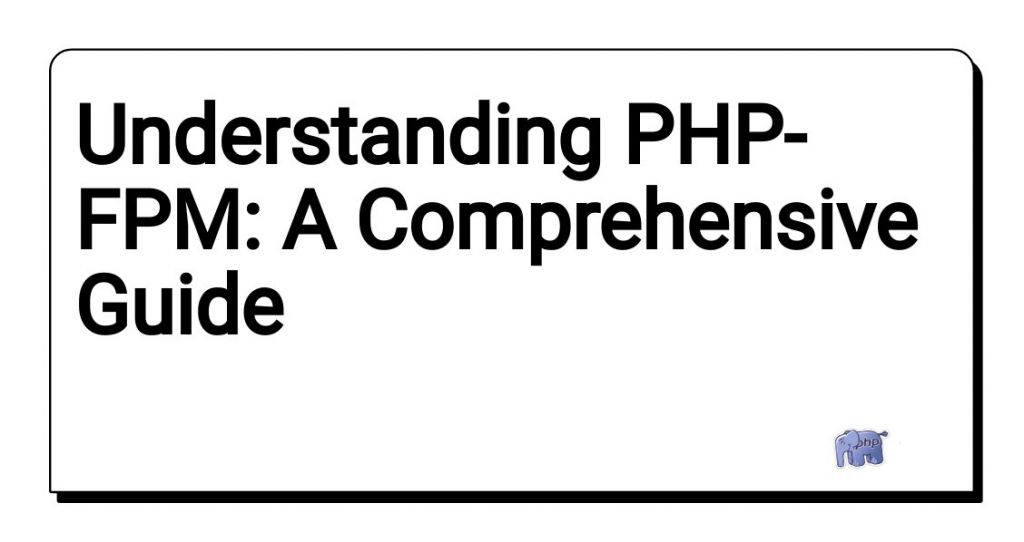
Understanding PHP-FPM: A Comprehensive Guide

Introduction PHP is still the most popular server-side scripting language in web development
PHP (Hypertext Preprocessor) is still the most popular server-side scripting language in web development. As websites and web applications grow in complexity and demand, developers are constantly seeking ways to optimize PHP's performance and efficiency. One such solution that has gained popularity is PHP-FPM (FastCGI Process Manager), a highly efficient alternative PHP FastCGI implementation. We will explore the world of PHP-FPM in this post, and learn about its features, advantages, and how it may greatly improve the speed of PHP-based applications.
What is PHP-FPM?
PHP-FPM is an alternative PHP FastCGI implementation that was introduced to overcome the limitations of the traditional PHP-CGI (Common Gateway Interface). It works as a process manager, managing PHP processes and handling PHP requests separately from the web server. By doing so, it can efficiently handle multiple PHP requests concurrently, leading to a significant reduction in latency and improved overall performance.
The Advantages of PHP-FPM
- Increased Performance - PHP-FPM's primary focus is on improving the performance of PHP-based applications. By maintaining separate PHP worker processes, it can handle a larger number of concurrent requests more efficiently. This approach significantly reduces the response time, making web applications feel more responsive and enhancing user experience.
- Resource Efficiency - With PHP-FPM, resources can be managed more effectively. Since it operates as a process manager, it can control the number of active PHP processes based on the server's resources and the incoming request load. This prevents resource wastage and optimizes the server's performance, allowing it to serve more users with fewer resources.
- Stability and Isolation - PHP-FPM provides a stable and secure environment for running PHP applications. If one PHP process encounters an error or becomes unresponsive, it won't affect other active processes. This isolation ensures that individual requests are isolated and do not impact the overall system stability.
- Customizable Pool Configuration - Developers can fine-tune PHP-FPM's pool configuration to match the specific needs of their applications. To get the best performance for various scenarios, configuration factors including the number of child processes, the maximum number of requests each child can manage, and other settings can be changed.
How PHP-FPM Works
PHP-FPM operates in tandem with the web server (e.g., Nginx or Apache). When a PHP request is received, the web server forwards it to the PHP-FPM process manager, which then handles the request via a pool of child processes. These child processes are separate instances of PHP, each capable of handling individual requests independently.
Configuring PHP-FPM
Configuring PHP-FPM can significantly impact the performance of a web application. It is essential to optimize the settings based on the server's hardware and expected traffic. Common configuration parameters include:
pm_max_children -This setting determines the maximum number of child processes allowed to run together. Setting an appropriate value ensures efficient resource utilization without causing memory issues.pm_max_requests -Thepm_max_requestsparameter controls the number of requests each child process can handle before it is recycled. Recycling processes regularly can help mitigate memory leaks in long-running PHP applications.pm_process_idle_timeout -This setting specifies the duration of time a child process can remain idle before it gets terminated. It helps free up resources when they are not actively serving requests.
PHP-FPM and Virtual Hosting
When hosting multiple websites or web applications on a single server, virtual hosting is a common practice. PHP-FPM plays a vital role in virtual hosting environments as it allows different websites to run separate PHP-FPM pools, ensuring isolation and security between the sites.
Conclusion
PHP-FPM is undoubtedly a game-changer in the realm of PHP-based web development. Its ability to manage PHP processes efficiently, coupled with its resource optimization, stability, and customization options, makes it a top choice for developers aiming to enhance the performance of their web applications. By choosing PHP-FPM, developers can deliver faster, more responsive web experiences to their users.
FAQs (Frequently Asked Questions)
- Is PHP-FPM compatible with both Nginx and Apache web servers?
Yes, PHP-FPM is compatible with both Nginx and Apache web servers. It can be integrated seamlessly with these servers to improve PHP's performance.
- Does PHP-FPM work with PHP versions other than PHP 7?
Yes, PHP-FPM is compatible with PHP versions 5.3 and above. However, it is recommended to use the latest stable PHP version for better performance and security.
- Can PHP-FPM be used with shared hosting environments?
Yes, PHP-FPM can be utilized in shared hosting environments, where multiple users share the same server resources. It allows for improved resource management and enhances the overall performance of PHP applications.
4. What is the main difference between PHP-FPM and PHP-CGI?
The primary difference lies in the way they handle PHP requests. PHP-FPM operates as a process manager, while PHP-CGI executes each PHP request independently. This process management approach in PHP-FPM provides better performance and resource utilization.
5. How can I check if PHP-FPM is running on my server?
To check if PHP-FPM is running on your server, you can use the command: ps aux | grep php-fpm . This will display the running PHP-FPM processes if it is installed and running correctly.

